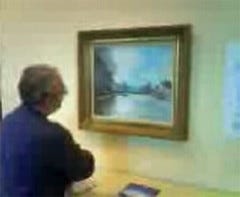Real fakes and fake fakes
My good friend Chris Skinner pointed me at a story about counterfeit art. The art in question, a “Picasso”, is apparently the work of a counterfeiter called Davd Henty. According to The Daily Telegraph, after being exposed as a forger a few years ago, “the publicity led to him being feted on television programmes and his copies - marked clearly as ‘Henty’s’ - now sell for £5,000 and upwards”. This reminded me of something I wrote a decade ago after a visit to Halifax, where I saw an interesting use case for RFID chips that were being bonded into the canvas used for painting. So here’s a picture of such a picture (and me).

This caught my eye all those years ago and it’s worth showing it again, because it’s a fascinating case study of using RFID in the real/counterfeit problem space. It’s not just about what’s real and what’s fake. The picture I am looking at here was painted by John Myatt. If you don’t recognise the name… well, his story is introduced in The Daily Telegraph this way: “From talented chart-topping songwriter, to Brixton prison for being involved in ‘the biggest art fraud of the 20th century’, John Myatt’s incredible life is now the subject of a Hollywood movie and his artistic talent the focus of a major TV series”.
Interesting guy. Take a look at his “genuine fakes”.
The reason Mr Myatt can make a good living doing genuine fake art, as noted in the Financial Times, is his notoriety as a master forger, which resulted in a six-month prison sentence in 1995. The picture I am looking at has RFID tags bonded to it, but in this case the purpose of the tags is to prove not only that the picture is a fake, rather than real, but that it’s a John Myatt fake and not someone else’s fake. So, basically, the idea is to use a combination of primary and secondary identification technologies to connect product and provenance in such a way as to prove that the picture is a real fake, if you see what I mean. Great stuff.
So if we are going to use technology to create a new identity infrastructure that works for things as well as people, it must not only distinguish real from fake, but fake from fake!
Talking about real fakes, rather than fake fakes, I have an important one at home. I got it after reading about a donation of drawings to Yad Vashem, Israel’s holocaust memorial. The drawings are of the men who worked in the once-secret Nazi operation to produce fake money, a story told in the brilliant film “The Counterfeiters”, which won the 2007 Oscar for best foreign film. It is the true story of Operation Bernhard, which was the Nazi plan to devastate the British economy. The idea, conceived at the very start of the Second World War, was to drop the worthless banknotes over England, thus causing economic instability, inflation and recession. Remember, in 1939 the German people had very recent memory of worthless paper currency devastating the economy, as is well chronicled in Adam Fergusson’s book “When Money Dies”.
The film is based on a memoir written by Adolf Burger, a Jewish Slovak typographer who was imprisoned in 1942 for forging baptismal certificates to save Jews from deportation. The Nazis took Burger and more than a hundred other Jews from a variety of trades—printing, engraving and at least one convicted master counterfeiter, Salomon Smolianoff—and moved them from different death camps to a special unit: “Block 19” in Sachsenhausen concentration camp. There they set about forging first the British and then the American currency. In the end, the prisoners forged around Sterling 132 million, which is about four billion quid in today’s prices.
The Nazis were never able to put their plot into operation. At the end of the war, they packed up all the printers’ plates and counterfeit bills into crates which they dumped into Lake Toplitz in Austria, from which they were subsequently retrieved. Some of the counterfeit notes went to the purchase of war materiel for the nascent Israeli army, some went to collectors. I bought an authenticated Operation Berhard counterfeit "white fiver” from a banknote collector and that is how I came to have a real fake on my wall at home.




